Microchannels Formed Using Metal Microdroplets
Abstract
:1. Introduction
2. Modeling and Experimental Setup
2.1. Control Equations
2.2. Volume of Fluid Method Modeling
3. Simulation Analysis
3.1. Microchannel Molding Process
3.2. Analysis of the Dynamic Process of Aluminum Microdroplet Deposition
3.2.1. Fluid Vector Change
3.2.2. Temperature Gradient Change
3.2.3. Microchannel Top Change
4. Experimental Validation
5. Conclusions
- (1)
- Both the simulation and experimental results show that the fusion of microdroplets with the substrate and between microdroplets can be controlled by adjusting the parameters to meet the fusion degree during on-demand injection.
- (2)
- Microdroplets are deposited onto the substrate, and then expand and then shrink. As heat is transferred to the substrate, the substrate temperature increases and the microdroplet temperature decreases and starts to solidify. Due to the rapid solidification of the unfolded part, the upper part of the microdroplet, which is still in the liquid state, will rebound and oscillate, and the solidification rate is greater than the oscillation rate of the microdroplet. As a result, the outer surface morphology of the microdroplet appears as an oscillating ripple caused by solidification.
- (3)
- The deposition spacing has a more significant effect on the molded part. An insufficient microdroplet distance during deposition can result in excessive part buildup, while an excessive microdroplet distance can cause collapsed or unsealed parts.
- (4)
- By simulating the observation of the oscillation phenomenon between microdroplets during microdroplet formation, the spacing can be used to control the degree of fusion between the microdroplets. This method is also applicable to the microdroplet injection of metals of other materials, which provides favorable conditions for manufacturing parts with different morphologies.
Author Contributions
Funding
Data Availability Statement
Conflicts of Interest
References
- Frazier, W.E. Direct digital manufacturing of metallic components: Vision and roadmap. In Proceedings of the 2010 International Solid Freeform Fabrication Symposium, Austin, TX, USA, 9–11 August 2010; University of Texas at Austin: Austin, TX, USA, 2010. [Google Scholar]
- Gao, W.; Zhang, Y.; Ramanujan, D.; Ramani, K.; Chen, Y.; Williams, C.B.; Wang, C.C.; Shin, Y.C.; Zhang, S.; Zavattieri, P. The status, challenges, and future of additive manufacturing in engineering. Comput. Aided Des. 2015, 69, 65–89. [Google Scholar]
- Fang, M.; Chandra, S.; Park, C.B. Building three dimensional objects by deposition of molten metal droplets. Rapid Prototyp. J. 2008, 14, 44–52. [Google Scholar] [CrossRef]
- Fang, M.; Chandra, S.; Park, C.B. Heat transfer during deposition of molten aluminum alloy droplets to build vertical columns. J. Heat Transf. 2009, 131, 112101. [Google Scholar] [CrossRef]
- Murr, L.E.; Gaytan, S.M.; Ramirez, D.A.; Martinez, E.; Hernandez, J.; Amato, K.N.; Shindo, P.W.; Medina, F.R.; Wicker, R.B. Metal fabrication by additive manufacturing using laser and electron beam melting technologies. J. Mater. Sci. Technol. 2012, 28, 1–14. [Google Scholar] [CrossRef]
- Suzuki, A.; Nakatani, H.; Kobashi, M. Machine learning surrogate modeling toward the design of lattice-structured heat sinks fabricated by additive manufacturing. Mater. Des. 2023, 230, 111969. [Google Scholar] [CrossRef]
- Zhang, D.; Qi, L.; Luo, J.; Yi, H.; Xiong, W.; Mo, Y. Parametric mapping of linear deposition morphology in uniform metal droplet deposition technique. J. Mater. Process. Technol. 2019, 264, 234–239. [Google Scholar] [CrossRef]
- Gao, F.; Sonin, A.A.; Sciences, P. Precise deposition of molten microdrops: The physics of digital microfabrication. Proc. R. Soc. London. Ser. A Math. Phys. Sci. 1994, 444, 533–554. [Google Scholar]
- Ryu, J.; Choi, D.H.; Kim, S. Three-dimensional numerical optimization of a manifold microchannel heat sink. Int. J. Heat Mass Transf. 2003, 46, 1553–1562. [Google Scholar] [CrossRef]
- Liu, Q.; Orme, M. High precision solder droplet printing technology and the state-of-the-art. J. Mater. Process. Technol. 2001, 115, 271–283. [Google Scholar] [CrossRef]
- Yu, L.; Lee, L.J.; Koelling, K.W. Flow and heat transfer simulation of injection molding with microstructures. Polym. Eng. Sci. 2004, 44, 1866–1876. [Google Scholar] [CrossRef]
- Li, H.; Wang, P.; Qi, L.; Zuo, H.; Zhong, S.; Hou, X. 3D numerical simulation of successive deposition of uniform molten Al droplets on a moving substrate and experimental validation. Comput. Mater. Sci. 2012, 65, 291–301. [Google Scholar] [CrossRef]
- Zhang, D.; Qi, L.; Luo, J.; Yi, H.; Hou, X. Direct fabrication of unsupported inclined aluminum pillars based on uniform micro droplets deposition. Int. J. Mach. Tools Manuf. 2017, 116, 18–24. [Google Scholar] [CrossRef]
- Pastuszko, R.; Kaniowski, R.; Wójcik, T.M.J.A.T.E. Comparison of pool boiling performance for plain micro-fins and micro-fins with a porous layer. Appl. Therm. Eng. 2020, 166, 114658. [Google Scholar] [CrossRef]
- Koşar, A.; Peles, Y. Boiling heat transfer in a hydrofoil-based micro pin fin heat sink. Int. J. Heat Mass Transf. 2007, 50, 1018–1034. [Google Scholar] [CrossRef]
- Krishnamurthy, S.; Peles, Y. Flow boiling of water in a circular staggered micro-pin fin heat sink. Int. J. Heat Mass Transf. 2008, 51, 1349–1364. [Google Scholar] [CrossRef]
- Qu, W.; Siu-Ho, A. Experimental study of saturated flow boiling heat transfer in an array of staggered micro-pin-fins. Int. J. Heat Mass Transf. 2009, 52, 1853–1863. [Google Scholar] [CrossRef]
- Pehlivan, H.; Taymaz, I.; İslamoğlu, Y. Experimental study of forced convective heat transfer in a different arranged corrugated channel. Int. Commun. Heat Mass Transf. 2013, 46, 106–111. [Google Scholar] [CrossRef]
- Ahmed, M.; Yusoff, M.Z.; Shuaib, N. Effects of geometrical parameters on the flow and heat transfer characteristics in trapezoidal-corrugated channel using nanofluid. Int. Commun. Heat Mass Transf. 2013, 42, 69–74. [Google Scholar] [CrossRef]
- Wan, Z.; Wang, Y.; Wang, X.; Tang, Y. Flow boiling characteristics in microchannels with half-corrugated bottom plates. Int. J. Heat Mass Transf. 2018, 116, 557–568. [Google Scholar] [CrossRef]
- Raj, E.; Lisik, Z.; Fiks, W. Influence of the manufacturing technology on microchannel structure efficiency. Mater. Sci. Eng. B 2011, 176, 311–315. [Google Scholar] [CrossRef]
- Koç, M.; Mahabunphachai, S. Feasibility investigations on a novel micro-manufacturing process for fabrication of fuel cell bipolar plates: Internal pressure-assisted embossing of micro-channels with in-die mechanical bonding. J. Power Sources 2007, 172, 725–733. [Google Scholar] [CrossRef]
- Law, M.; Lee, P.-S.; Balasubramanian, K. Experimental investigation of flow boiling heat transfer in novel oblique-finned microchannels. Int. J. Heat Mass Transf. 2014, 76, 419–431. [Google Scholar] [CrossRef]
- Deng, D.; Wan, W.; Qin, Y.; Zhang, J.; Chu, X. Flow boiling enhancement of structured microchannels with micro pin fins. Int. J. Heat Mass Transf. 2017, 105, 338–349. [Google Scholar] [CrossRef]
- Deng, D.; Tang, Y.; Liang, D.; He, H.; Yang, S. Flow boiling characteristics in porous heat sink with reentrant microchannels. Int. J. Heat Mass Transf. 2014, 70, 463–477. [Google Scholar] [CrossRef]
- Zhang, C.; Ma, J.; Liang, X.; Luo, F.; Cheng, R.; Gong, F. Fabrication of metallic bipolar plate for proton exchange membrane fuel cells by using polymer powder medium based flexible forming. J. Mater. Process. Technol. 2018, 262, 32–40. [Google Scholar] [CrossRef]
- Waldvogel, J.; Poulikakos, D. Solidification phenomena in picoliter size solder droplet deposition on a composite substrate. Int. J. Heat Mass Transf. 1997, 40, 295–309. [Google Scholar] [CrossRef]
- Bhardwaj, R.; Longtin, J.P.; Attinger, D. Interfacial temperature measurements, high-speed visualization and finite-element simulations of droplet impact and evaporation on a solid surface. Int. J. Heat Mass Transf. 2010, 53, 3733–3744. [Google Scholar] [CrossRef]
- Carlson, A.; Do-Quang, M.; Amberg, G. Dissipation in rapid dynamic wetting. J. Fluid Mech. 2011, 682, 213–240. [Google Scholar] [CrossRef]
- Pasandideh-Fard, M.; Aziz, S.; Chandra, S.; Mostaghimi, J. Cooling effectiveness of a water drop impinging on a hot surface. Int. J. Heat Fluid Flow 2001, 22, 201–210. [Google Scholar] [CrossRef]
- Suli, L.; Zhengying, W.; Jun, D.; Pei, W.; Bingheng, L. A numerical analysis on the metal droplets impacting and spreading out on the substrate. Rare Met. Mater. Eng. 2017, 46, 893–898. [Google Scholar] [CrossRef]
- Pasandideh-Fard, M.; Bussmann, M.; Chandra, S. Simulating droplet impact on a substrate of arbitrary shape. At. Sprays 2001, 11, 397–414. [Google Scholar] [CrossRef]
- Qi, L.; Yi, H.; Luo, J.; Zhang, D.; Shen, H.J.R.; Manufacturing, C.-I. Embedded printing trace planning for aluminum droplets depositing on dissolvable supports with varying section. Robot. Comput. Manuf. 2020, 63, 101898. [Google Scholar] [CrossRef]
- Du, J.; Wei, Z. Numerical analysis of pileup process in metal microdroplet deposition manufacture. Int. J. Therm. Sci. 2015, 96, 35–44. [Google Scholar] [CrossRef]
- Chao, Y.-p.; Qi, L.-h.; Zuo, H.-s.; Luo, J.; Hou, X.-h.; Li, H.-j. Remelting and bonding of deposited aluminum alloy droplets under different droplet and substrate temperatures in metal droplet deposition manufacture. Int. J. Mach. Tools Manuf. 2013, 69, 38–47. [Google Scholar] [CrossRef]
- Waldvogel, J.; Poulikakos, D.; Wallace, D.; Marusak, R. Transport phenomena in picoliter size solder droplet dispension. J. Heat Transf. 1996, 118, 148–156. [Google Scholar] [CrossRef]
- Butty, V.; Poulikakos, D.; Giannakouros, J. Three-dimensional presolidification heat transfer and fluid dynamics in molten microdroplet deposition. Int. J. Heat Fluid Flow 2002, 23, 232–241. [Google Scholar] [CrossRef]
- Chin, R.; Beuth, J.; Amon, C.H. Successive deposition of metals in solid freeform fabrication processes, Part 1: Thermomechanical models of layers and droplet columns. J. Manuf. Sci. Eng. 2001, 123, 623–631. [Google Scholar] [CrossRef]
- Aluminum Association. Aluminum: Properties and Physical Metallurgy; ASM International: Almere, The Netherlands, 1984. [Google Scholar]
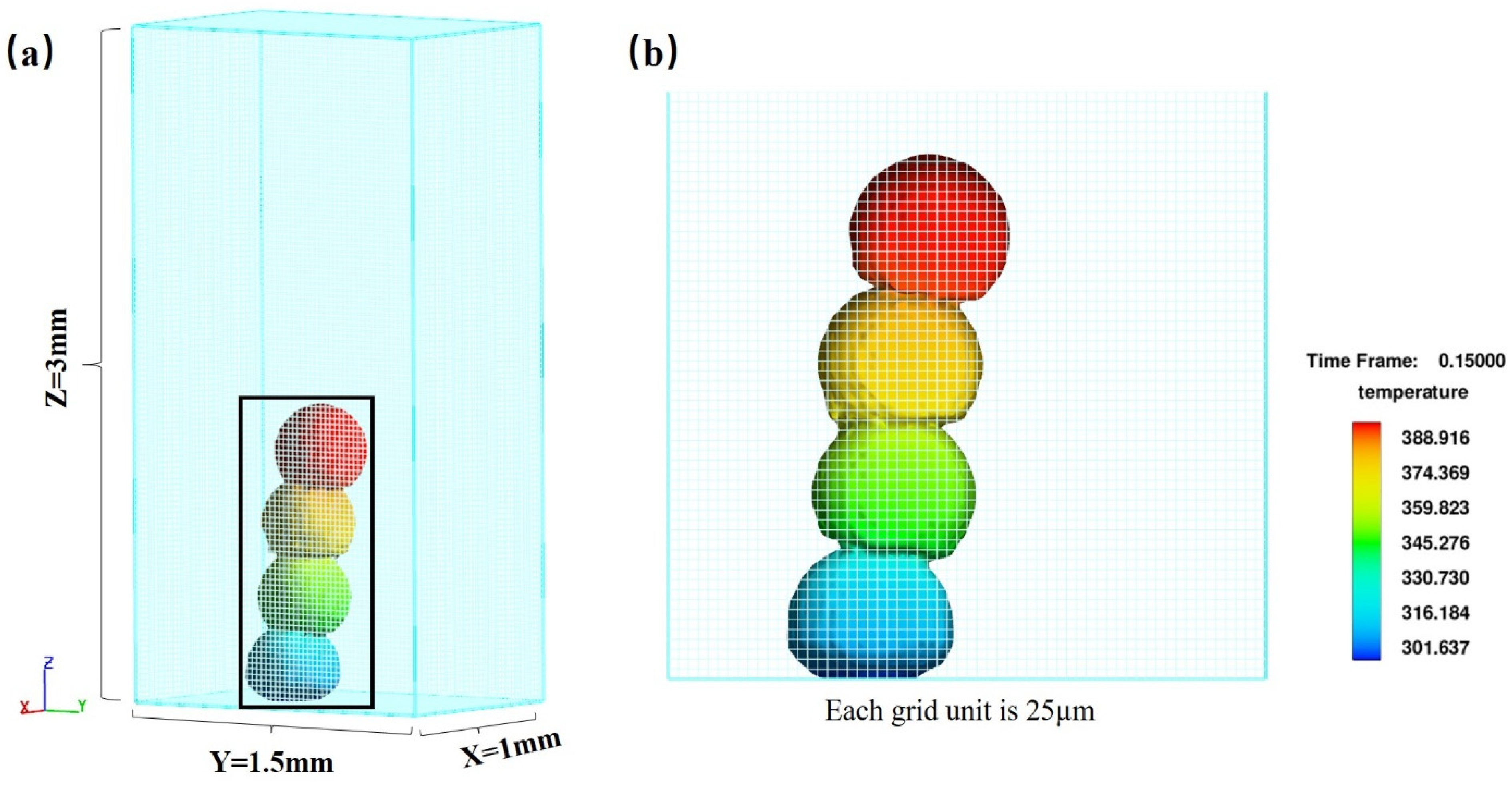
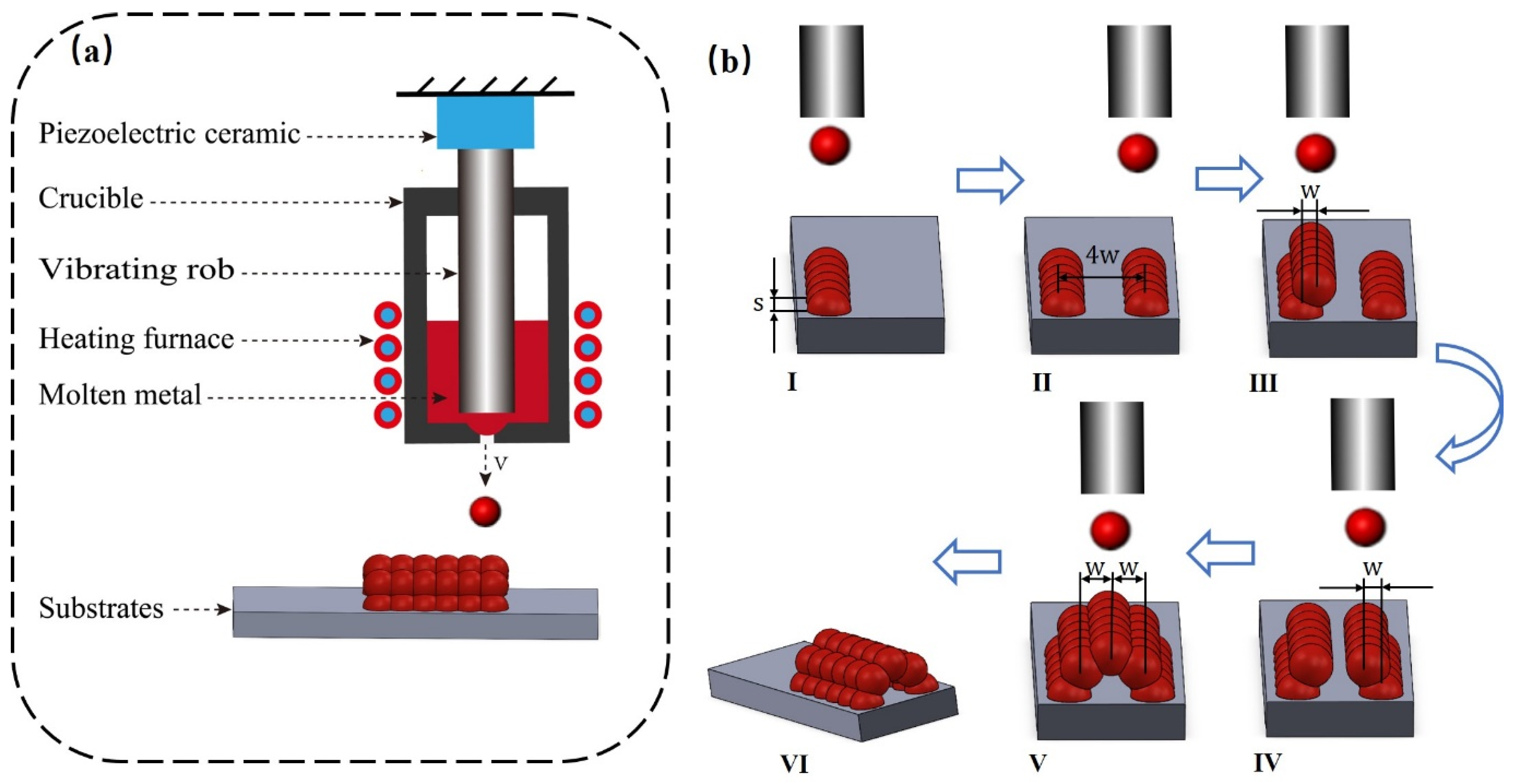
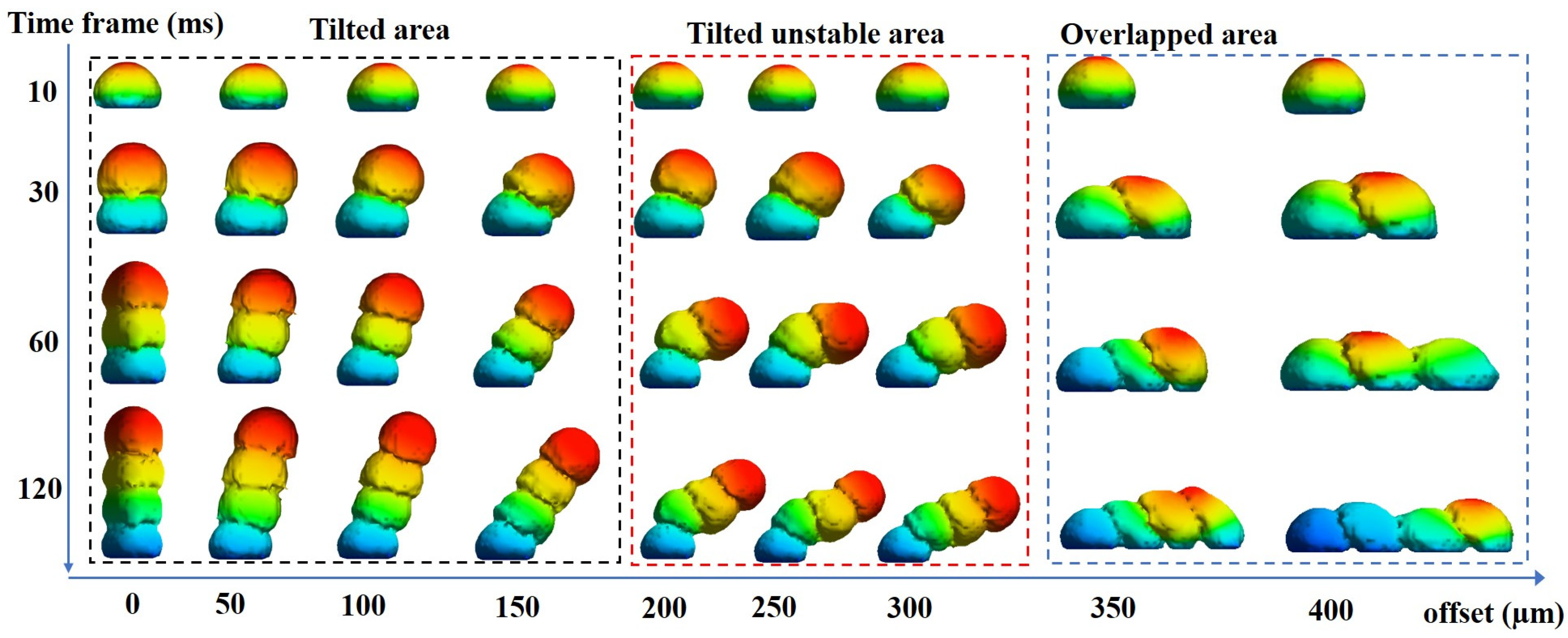
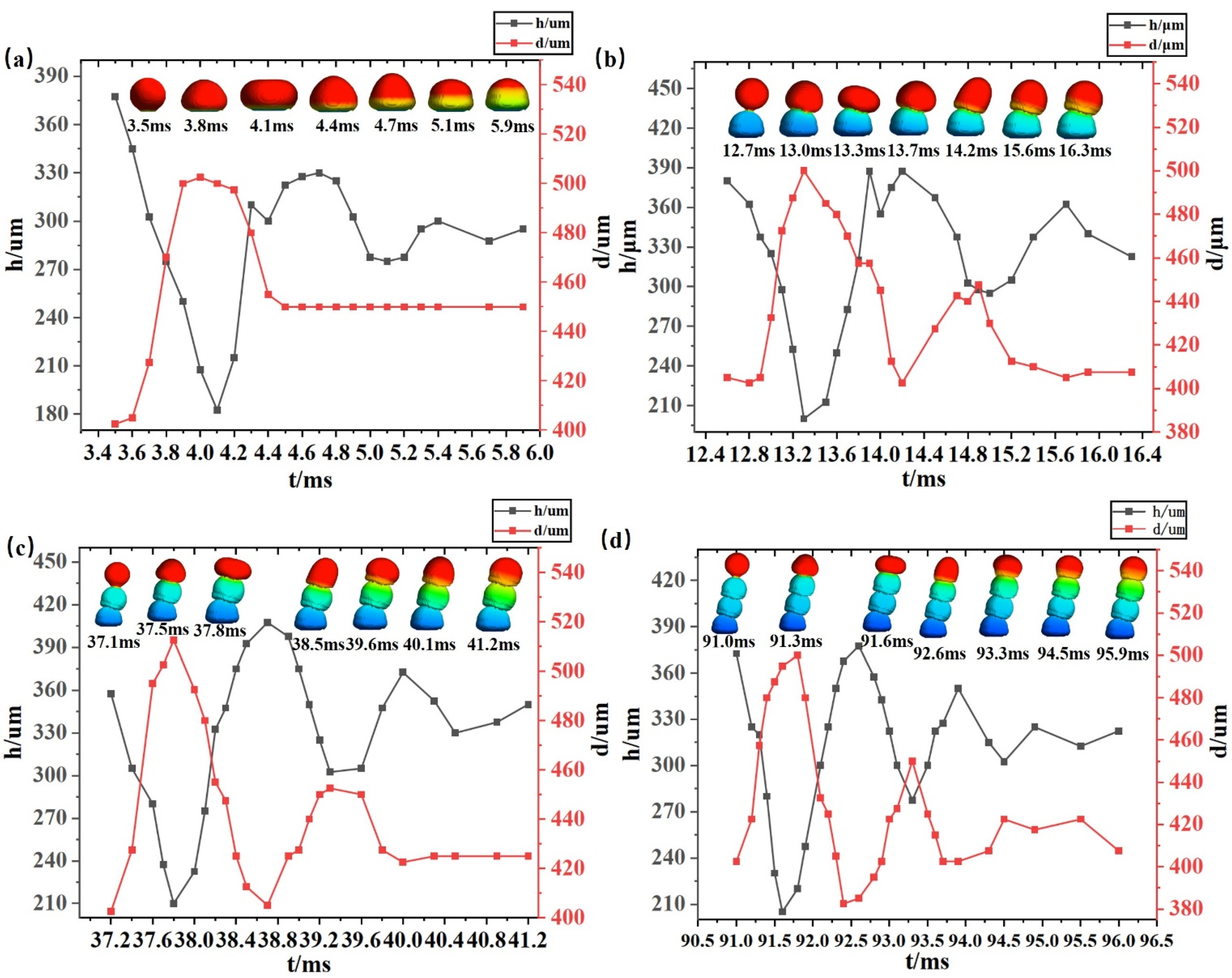
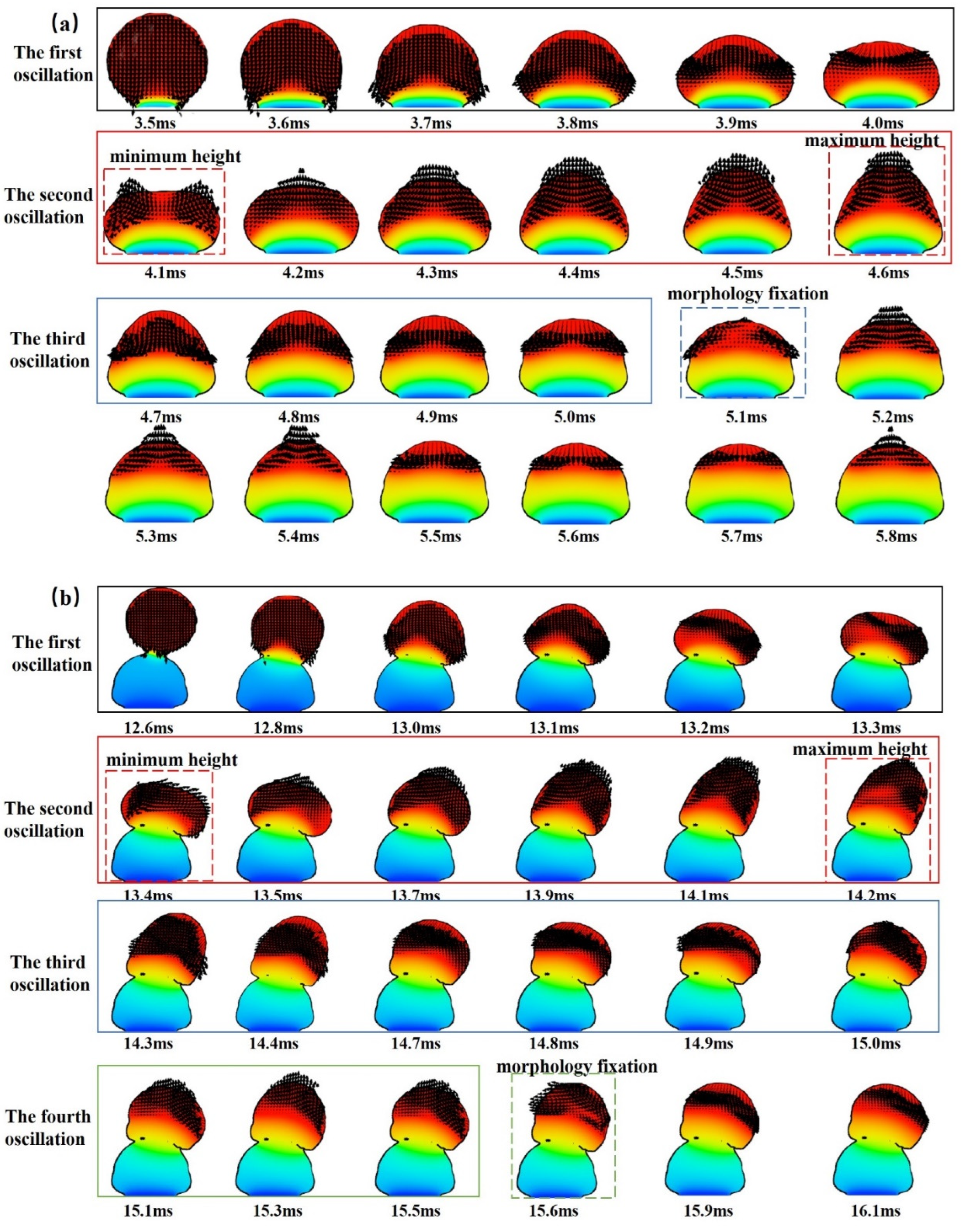
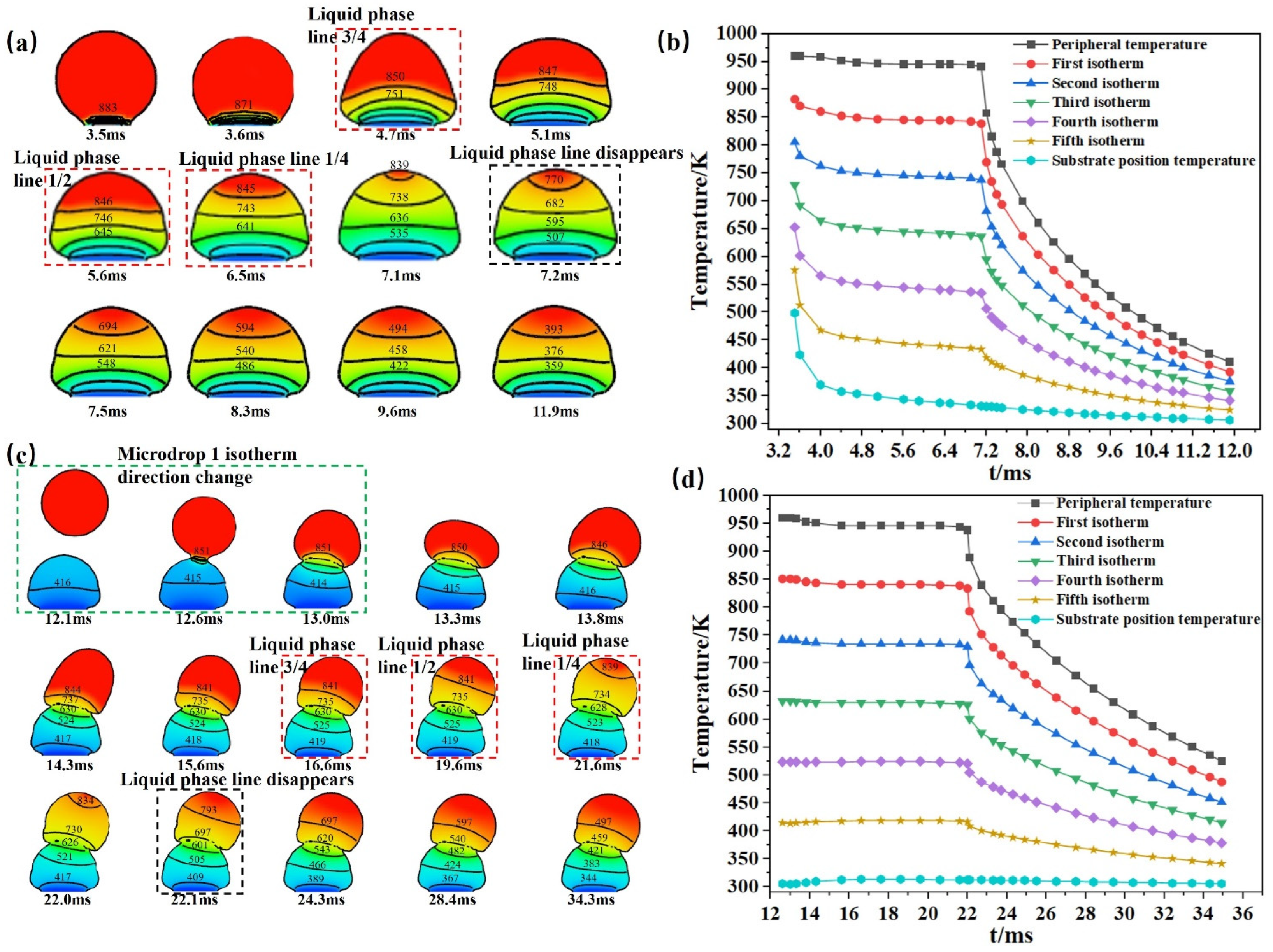
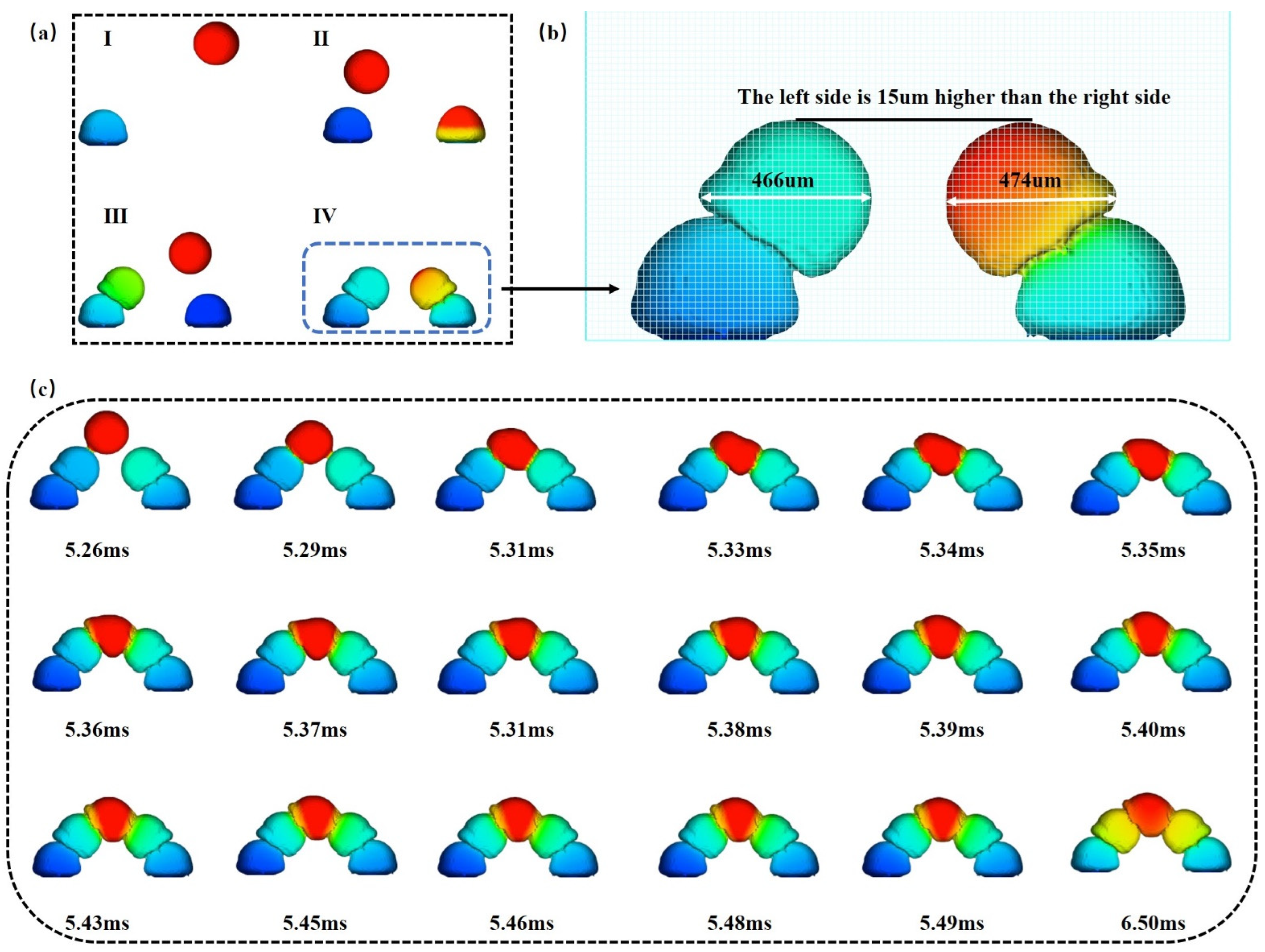

| Physical Properties | Value |
|---|---|
| Density (kg/m3) | ρ = 2368 |
| Dynamics viscosity (Pa·s) | μ = 1.257 × 10−3 |
| Surface tension coefficient (N/m) | σ = 0.868 |
| Heat conductivity coefficient (W/(m·K)) | ks = 220 kl = 96.4 |
| Specific heat capacity (J/(kg·K)) | Cps = 1135 Cpl = 1086 |
| Latent heat for solidification (J/kg) | L = 397,500 |
| Liquidus temperature (K) | Tl = 934 |
| Solidus temperature (K) | Ts = 933 |
| Static contact angle (°) | 90 |
| Parameters | Value |
|---|---|
| 0.6 | |
| 0.35 | |
| 3 | |
| 960 | |
| 300 | |
| 0.4 | |
| 50~60 |
Disclaimer/Publisher’s Note: The statements, opinions and data contained in all publications are solely those of the individual author(s) and contributor(s) and not of MDPI and/or the editor(s). MDPI and/or the editor(s) disclaim responsibility for any injury to people or property resulting from any ideas, methods, instructions or products referred to in the content. |
© 2023 by the authors. Licensee MDPI, Basel, Switzerland. This article is an open access article distributed under the terms and conditions of the Creative Commons Attribution (CC BY) license (https://creativecommons.org/licenses/by/4.0/).
Share and Cite
Zhang, D.; Jing, C.; Guo, W.; Xiao, Y.; Luo, J.; Qi, L. Microchannels Formed Using Metal Microdroplets. Micromachines 2023, 14, 1922. https://doi.org/10.3390/mi14101922
Zhang D, Jing C, Guo W, Xiao Y, Luo J, Qi L. Microchannels Formed Using Metal Microdroplets. Micromachines. 2023; 14(10):1922. https://doi.org/10.3390/mi14101922
Chicago/Turabian StyleZhang, Daicong, Chunhui Jing, Wei Guo, Yuan Xiao, Jun Luo, and Lehua Qi. 2023. "Microchannels Formed Using Metal Microdroplets" Micromachines 14, no. 10: 1922. https://doi.org/10.3390/mi14101922
APA StyleZhang, D., Jing, C., Guo, W., Xiao, Y., Luo, J., & Qi, L. (2023). Microchannels Formed Using Metal Microdroplets. Micromachines, 14(10), 1922. https://doi.org/10.3390/mi14101922






